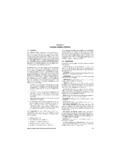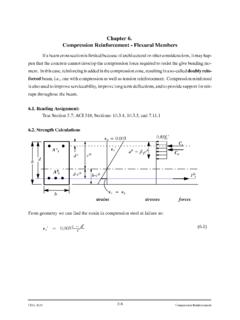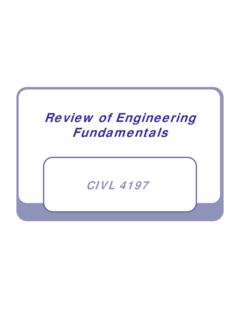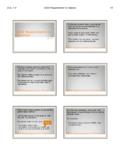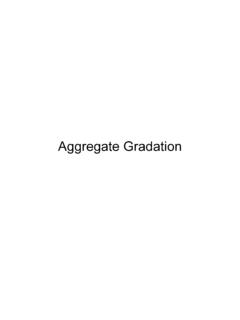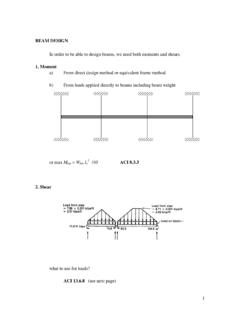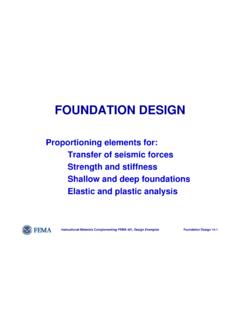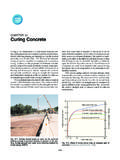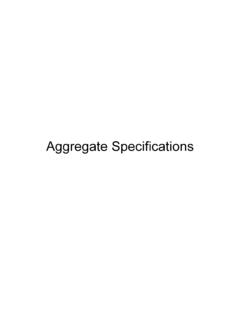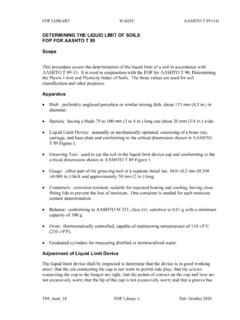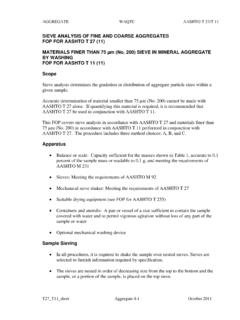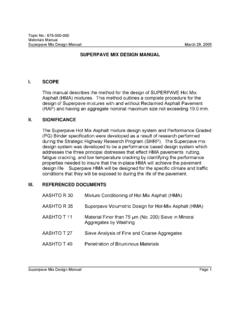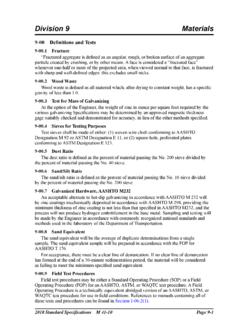Transcription of Aggregates for Concrete - Department of Civil …
1 The importance of using the right type and quality ofaggregates cannot be overemphasized. The fine andcoarse Aggregates generally occupy 60% to 75% of theconcrete volume (70% to 85% by mass) and strongly influ-ence the Concrete s freshly mixed and hardened proper-ties, mixture proportions, and economy. Fine Aggregates (Fig. 5-1) generally consist of natural sand or crushedstone with most particles smaller than 5 mm ( in.).Coarse Aggregates (Fig. 5-2) consist of one or a com-CHAPTER 5 Aggregates for Concretebination of gravels or crushed stone with particlespredominantly larger than 5 mm ( in.) and generallybetween mm and mm (3 8in.)
2 And 11 2in.). Somenatural aggregate deposits, called pit-run gravel, consistof gravel and sand that can be readily used in concreteafter minimal processing. Natural gravel and sand areusually dug or dredged from a pit, river, lake, or stone is produced by crushing quarry rock, boul-ders, cobbles, or large-size gravel. Crushed air-cooledblast-furnace slag is also used as fine or coarse Aggregates are usually washed and graded at thepit or plant. Some variation in the type, quality, cleanli-ness, grading, moisture content, and other properties isexpected. Close to half of the coarse Aggregates used inportland cement Concrete in North America are gravels;most of the remainder are crushed occurring Concrete Aggregates are a mixtureof rocks and minerals (see Table 5-1).
3 A mineral is a natu-rally occurring solid substance with an orderly internalstructure and a chemical composition that ranges withinnarrow limits. Rocks, which are classified as igneous, sedi-mentary, or metamorphic, depending on origin, are gener-ally composed of several minerals. For example, granitecontains quartz, feldspar, mica, and a few other minerals;most limestones consist of calcite, dolomite, and minoramounts of quartz, feldspar, and clay. Weathering anderosion of rocks produce particles of stone, gravel, sand,silt, and Concrete , or crushed waste Concrete , is afeasible source of Aggregates and an economic reality,especially where good Aggregates are scarce.
4 Conven-tional stone crushing equipment can be used, and newequipment has been developed to reduce noise and must conform to certain standards foroptimum engineering use: they must be clean, hard,strong, durable particles free of absorbed chemicals, coat-ings of clay, and other fine materials in amounts that couldaffect hydration and bond of the cement paste. Aggregateparticles that are friable or capable of being split are unde-sirable. Aggregates containing any appreciable amountsof shale or other shaly rocks, soft and porous materials,Fig. 5-1. Closeup of fine aggregate (sand). (69792)Fig. 5-2. Coarse aggregate . Rounded gravel (left) andcrushed stone (right).
5 (69791)79 HOMEPAGE should be avoided; certain types of chert should be espe-cially avoided since they have low resistance to weather-ing and can cause surface defects such as of the constituents of an aggregatecannot alone provide a basis for predicting the behavior ofaggregates in service. Visual inspection will often discloseweaknesses in coarse Aggregates . Service records areinvaluable in evaluating Aggregates . In the absence of aperformance record, the Aggregates should be testedbefore they are used in Concrete . The most commonly usedaggregates sand, gravel, crushed stone, and air-cooledblast-furnace slag produce freshly mixed normal-weightconcrete with a density (unit weight) of 2200 to 2400kg/m3(140 to 150 lb/ft3).
6 Aggregates of expanded shale,clay, slate, and slag (Fig. 5-3) are used to produce struc-tural lightweight Concrete with a freshly mixed densityranging from about 1350 to 1850 kg/m3(90 to 120 lb/ft3).Other lightweight materials such as pumice, scoria,perlite, vermiculite, and diatomite are used to produceinsulating lightweight concretes ranging in density fromabout 250 to 1450 kg/m3(15 to 90 lb/ft3). Heavyweightmaterials such as barite, limonite, magnetite, ilmenite,hematite, iron, and steel punchings or shot are used toproduce heavyweight Concrete and radiation-shieldingconcrete (ASTM C 637 and C 638). Only normal-weightaggregates are discussed in this chapter.
7 See Chapter 18for special types of Aggregates and Aggregates should meet the require-ments of ASTM C 33 or AASHTO M 6/M 80. These speci-fications limit the permissible amounts of deleterioussubstances and provide requirements for aggregate char-acteristics. Compliance is determined by using one ormore of the several standard tests cited in the followingsections and tables. However, the fact that aggregatessatisfy ASTM C 33 or AASHTO M 6/M 80 requirementsdoes not necessarily assure defect-free adequate consolidation of Concrete , the desirableamount of air, water, cement, and fine aggregate (that is,the mortar fraction) should be about 50% to 65% byabsolute volume (45% to 60% by mass).
8 Rounded aggre-gate, such as gravel, requires slightly lower values, whilecrushed aggregate requires slightly higher values. Fineaggregate content is usually 35% to 45% by mass orvolume of the total aggregate OF AGGREGATESThe important characteristics of Aggregates for Concrete arelisted in Table 5-2 and most are discussed in the followingsection:GradingGrading is the particle-size distribution of an aggregate asdetermined by a sieve analysis (ASTM C 136 or AASHTO80 Design and Control of Concrete Mixtures EB001 Table 5-1. Rock and Mineral Constituents inAggregatesMineralsIgneous rocksMetamorphic rocksSilicaGraniteMarbleQuartzSyeniteMet aquartziteOpalDioriteSlate ChalcedonyGabbroPhyllite TridymitePeridotiteSchist CristobalitePegmatiteAmphibolite SilicatesVolcanic glassHornfels FeldsparsObsidianGneiss Ferromagnesian PumiceSerpentiniteHornblendeTuffAugite ScoriaClayPerliteIllitesPitchstoneKaolin sFelsiteChloritesBasaltMontmorillonitesM icaSedimentary rocksZeoliteConglomerateCarbonateSandsto neCalciteQuartziteDolomiteGraywackeSulfa teSubgraywackeGypsumArkoseAnhydriteClays tone, siltstone,Iron sulfideargillite.)
9 And shalePyriteCarbonatesMarcasiteLimestoneP yrrhotiteDolomiteIron oxideMarlMagnetiteChalkHematiteChertGoet hitelmeniteLimoniteFor brief descriptions, see Standard Descriptive Nomenclature ofConstituents of Natural Mineral Aggregates (ASTM C 294).Fig. 5-3. Lightweight aggregate . Expanded clay (left) andexpanded shale (right). (69793)T 27). The range of particle sizes in aggregate is illustratedin Fig. 5-4. The aggregate particle size is determined byusing wire-mesh sieves with square openings. The sevenstandard ASTM C 33 (AASHTO M 6/M 80) sieves for fineaggregate have openings ranging from 150 m to mm(No. 100 sieve to 3 8in.). The 13 standard sieves for coarseaggregate have openings ranging from mm to 100 mm( in.
10 To 4 in.). Tolerances for the dimensions of open-ings in sieves are listed in ASTM E 11 (AASHTO M 92).Size numbers (grading sizes) for coarse aggregatesapply to the amounts of aggregate (by mass) in percent-ages that pass through an assortment of sieves (Fig. 5-5).For highway construction, ASTM D 448 (AASHTO M 43)lists the same 13 size numbers as in ASTM C 3381 Chapter 5 Aggregates for ConcreteTable Characteristics and Tests of AggregateCharacteristic SignificanceTest designation*Requirement or item reportedResistance to abrasionIndex of aggregate quality;ASTM C 131(AASHTO T 96)Maximum percentage ofand degradation wear resistance of floors andASTM C 535weight loss.
